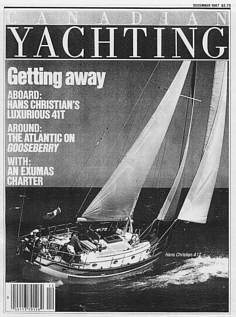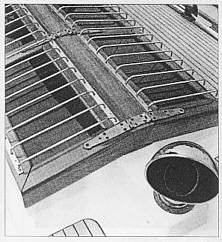

Canadian Yachting
Testi Hans Christian 41 Traditional Cutter purjeveneestä.

The yacht appeared solidly built and sound throughout. I certainly would not hesitate to take the design offshore

The butterfly skylight provides an air of elegance on deck - as well as light and ventilation below

Deck chests hold everything from winch handles to fenders; the grab rail with belaying pins (and another chest) helps sort out lines and halyards.

Hans Christian Finland, SGF Oy Tyrskyvuori 4, 02320 Espoo Puhelin 0400-320321
The 41 T is the culmination of fine-tuning the features and aesthetics of 11 existing Hans Christian Yachts Inc. designs (Hans Christian also produces several motor yachts) while retaining the traditional form that appealed to the 600 owners of her sisterships sailing throughout the world. If this nicely appointed yacht were a race horse, she'd be described as having good bloodlines.
The selective breeding of the 41 T was overseen by one of Hans Christian's many independent designers, Scott Sprague of Bainbridge Island in Washington state. Sprague's keen instinct for the soothing hull form was illustrated in the review of his 43-foot cruising tug in Canadian Yachting's July 1985, issue. Sprague's own bloodlones stand up well to scrutiny: his father served as west coast designer Bill Garden's engineer when Garden's office was in Washington state.
Hans Christian's head office is now in Annapolis, Maryland. It's Taiwanese yard produced one-third of that country's sailboat exports last year. Hans Christian is also the oldest Taiwanese boatbuilder still selling to the North American market - 18 years, in fact. (Pääkonttori nykyään Euroopassa ja valmistus Thaimaassa)
STRUCTURE
The 41 T retains the canoe stern, spoon bow and attractive bowsprit that typify the Hans Christian line. She has a finer entry than her sisters, curving to a long fin keel which offers up lateral resistance as well as seagoing directional stability. The cast-iron keel is encased in fibreglass to add enormous strength to the fin - the yacht is designed to stand upright on the keel if grounded.
The designers listened to Hans Christian customers and made provisions for a generator, air conditioner, microwave, oven, autopilot, wind-vane system and heavy anchor windlass with storage and appropriate hull form buoyancy for the necessary chain rode. They also placed tankage where possible in the 41 T below the sole level to improve the ballast/displacement ratio and preserve storage space under berths and in lockers. The designers say the yacht can carry up to 7,500 pounds (3.700 kgs) extra gear without putting her off her basic lines.
With 35,500 pounds of displacement shouldered by a 36-foot waterline and driven by 1,148 square feet of sail (cutter rig with a yankee genoa), she isn't your basic quarterhorse. But that is not her raison d'etre. The 41 T is a luxorious world cruiser with all amenities accounted for.
When I clamber aboard a boat for the first time, my attention is first on construction, not perks. I peek into bilges, check the bulkhead-to-hull bonding technique and thoroughly scrutinize the system used to join the hull-deck joint. Then I turn to the through-hull fittings. If they're not sea cocks accompanied by backing plates, I jump up and down.
It was not necessary for me to resort to a temper tantrum. The 41 T passed in all these areas with flying colours. The yacht appeared solidly built and sound throughout. I certainly would not hesitate to take the design offshore.
INTERIORS
My interest in a yacht's natural lightning and ventilation developed from having sailed designs so wanting, by my standards, in this area. The 41 T's bronze port lights allowed adequate light into the interior, and sufficient ventilation poured through a massive skylight arrangement at the centre deck. Additional light and air were supplied by individual compartment hatches opening on deck.
Cosmetically, the 41 T exudes natural warmth through the virtual acres of teak on deck and below. Doors, srawer facings and companionway steps are solid teak. The joinery work is some of the finest I've seen. But the piéce de résistance was the marble galley top and marble tiled shower ensemble in the forward cabin.
When I asked owner Jerry Cockerill if the marble countertop was solid or facing, he quickly supplied a solid marble sample for the inspection. The shower ensemble must be seen (end used) to be believed.
The velour cushions and backrests in the main saloon are deeply padded and comfortable. The galley is well designed, and I could imagine a meal being prepared in a heavy seaway without excessive gyration or lamentation from the cook.
The navigation station is functional and modern. A nice touch is the swing-hinged, cushion-backed seat for the navigator, allowing him to maintain easy access to all navigational aids and toys the owner requires. A drop-down electrical panel conceals one of the neatest wiring jobs I have seen in a yacht.
The fuel storage tanks are black iron encased in fibreglass. Water tanks are stainless steel with tank clean-out access. Alla tanks have bronze valve manifolds, assuring isolation of tank fluids. Plumbing is copper, sea cocks are bronze, and a full hot-and-cold pressure water system is standard.
The 41 T's 12-volt lighting system is up to scratch, with courtesy lights and a dual white-and-red light switch on overhead lighting for night vision providing welcome innovations.
To be sure, the 41 T could be fairly described as "opulent". But would she sail?
SAILING
The August afternoon of the test sail provided a good opportunity to answer that question, with 15 to 18 knots being delivered by a freshening offshore Lake Ontario breeze.
I headed out with Cockerill and Bob Barker of North Shore Marine of Port Credit, the Ontario representative for the Hans Christian line. We decided to bend on the entire sail inventory, and I was pleasantly surprised. Before long we were touching seven knots on a close reach. Hardening up, the 41 T handled the weather well. Although we slowed to 5 1/2 knots, the yacht sailed well to windward with an easy motion above and, most importantly, below. She cut through the wave pattern without a fuss, proving to be dry and seakindly.
Sailing under yankee and main alone, the 41 T tracked well, maintaining good speed of five knots. The wheel eas light and well balanced, with fingertip steering being the order of the day. She tacked through 90 degrees and came around quickly for a design with fairly long keel profile.
Off the wind, the 41 T kicked up her heels, riding solidly through the crests while tracking as if on rails. I like a cutter rig, particularly for sail management offshore, and the 41 T's twin Profurl headsail furling systems made sailing downright leisurely.
The Kenyon single-spreader rig was amply stayed, incorporating traditional 1 x 19 wire machine-swaged to Merriman turnbuckles. The deck-stepped rig is supported belowdeck by a stainless steel compression tube.
One of the 41 T's nice features is the placement of it's 66-hp four-cylinder Yanmar marine diesel. No crawling into the bilge to check the oil here. The engine is conveniently located almost amidship under the galley area, allowing the mechanic to work directly over it.
With a three-blade 21-inch prop, the yacht will move smartly at 2,000 rpm. I ventured below during our motoring into the slip and was cheered by the lack of engine noise. no noticeable vibration was throuwn off by the running engine.
